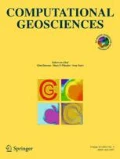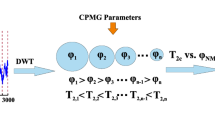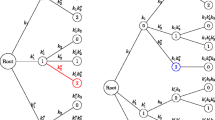Abstract
The problem of determining capillary pressure functions from centrifuge data leads to an integral equation of the form
∫ a x K(x,t)f(t) dt=g(x),x∈[a,b],(1)
where the kernel K is known exactly and given by the underlying mathematical model. g is only known with a limited degree of accuracy in a finite and discrete set of points x 1,...,x M . However, the sought function f(t) is continuous. By the nature of the right-hand side, g(x), equation (1) is a discrete inverse problem which is ill-posed in the sense of Hadamard [9]. By a parameterization of the sought function, equation (1) reduces to a system of linear equations of the form
Ac=b+ ε,
where b is the observation vector and A arises from discretization of the forward problem. ε is the error vector associated with b, and c contains the model parameters. The matrix A is usually ill-conditioned. The ill-conditioning is closely connected to the parameterization of the problem [23].
In this paper a semi-iterative regularization method for solving the Volterra integral equation in the ℓ2-norm, namely, Brakhage's ν-method [2], is investigated. The iterative method is tested on synthetically generated, and on experimental data.
Similar content being viewed by others
References
Å. Björck, Numerical Methods for Least Squares Problems(SIAM, Philadelphia, PA, 1996).
H. Brakhage, On ill-posed problems and the method of conjugate gradients, in: Inverse and Ill-Posed Problems, eds. H.W. Engel and C.W. Groetch (1987).
W.P. Dulaney, Jr., Estimation of capillary pressure from centrifuge data, Master's thesis, Texas A & M University, USA (May 1986).
L. Élden, A weighted pseudoinverse, generalized singular values, and constrained least square prob-lems, BIT 22 (1982) 487–501.
H.W. Engl, M. Hanke and A. Neubauer, Regularization of Inverse Problems(Kluwer Academic, Dor-drecht, 1996).
P. Forbes, Simple and accurate method for converting centrifuge data into drainage and imbibition capillary pressure curves, in: Society of Core Analysts Annual Conference, San Antonio, SCA, 1991, pp. 20–22.
P.L. Forbes, ed., Centrifuge Data Analysis Techniques – A Survey from the Society of Core Analysts(September 1997).
G.H. Golub and C.F. van Loan, Matrix Computations, 2nd ed. (Johns Hopkins Univ. Press, Baltimore, MD, 1989).
J. Hadamard, Lectures on the Cauchy Problem in Linear Partial Differential Equations(Yale Univ. Press, 1923).
P.C. Hansen, Analysis of discrete ill-posed problems by means of the L-curve, SIAM Rev. 34(4) (1992) 561–580.
P.C. Hansen, Regularization tools, a Matlab package for analysis and solution of discrete ill-posed problems, Numer. Algorithms 6 (1994) 1–35.
P.C. Hansen, Rank-deficient and discrete ill-posed problems, Ph.D. thesis, Technical University of Denmark (1996).
P.C. Hansen and D.P. O'Leary, The use of the L-curve in the regularization of discrete ill-posed problems, SIAM J. Sci. Comput. 14 (1993) 1487–1503.
G.L. Hassler and E. Brunner, Measurements of capillary pressures in small core samples, Trans. AIME 160 (1945) 114–123.
M.R. Hestenes and E. Stiefel, Methods of conjugate gradients for solving linear system, J. Res. Nat. Bur. Standards B 49 (1952) 409–436.
C.L. Lawson and R.J. Hanson, Solving Least Square Problems(Prentice-Hall, Englewood, Cliffs, NJ, 1974).
K. Miller, Least square methods for ill-posed problems with prescribed bound, SIAM J. Math. Anal. 1 (1970) 52–74.
K. Nordaas, Determination of the capillary pressure curve from centrifuge data, Master's thesis, Uni-versity of Bergen, Norway (March 1996).
L.L. Schumaker, Spline Functions: Basic Theory(Wiley, New York, 1981).
S.S. Shapiro and M.B. Wilk, An analysis of variance test for normality (complete samples), Bio-metrika 52 (1965) 519–611.
S. Subbey, Regularizing the Volterra integral equation – the capillary pressure case, Ph.D. thesis, University of Bergen, Norway (2000).
S. Subbey and J.-E. Nordtvedt, Estimation in the presence of outliers, the capillary pressure case, in: Multiphase Flows and Transport in Porous Media – State of the Art, eds. Z. Chen, R.E. Ewing and Z.-C. Shi, Lecture Notes in Physics (Springer, Berlin, 2000) pp. 299–310.
S. Subbey, J.-E. Nordtvedt, S.Å. Gustafson and M. Christie, Estimating capillary pressure functions from centrifuge data, Inverse Problems (2001) submitted.
C.R. Vogel, Solving ill-conditioned linear systems using the conjugate gradient method, Report, De-partment of Mathematical Sciences, Montana State University, USA (1987).
Author information
Authors and Affiliations
Rights and permissions
About this article
Cite this article
Subbey, S., Nordtvedt, JE. Capillary Pressure Curves from Centrifuge Data: A Semi-Iterative Approach. Computational Geosciences 6, 207–224 (2002). https://doi.org/10.1023/A:1019943419164
Issue Date:
DOI: https://doi.org/10.1023/A:1019943419164




